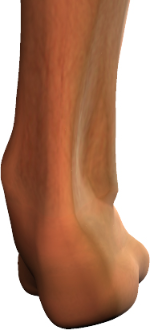 There has been a lot of talk about the term "Pronation". For a start pronation is not bad. It is an active and natural shock absorbing movement of the foot. It's characterised by the foot rolling inward and the arch lowering. This is a normal movement that commences immediately after the foot makes contact with the ground. Whilst it is primarily a shock absorbing movement it also allows the foot to adjust and adapt to the ground. In this way your foot can quickly adjust to uneven surfaces.
There has been a lot of talk about the term "Pronation". For a start pronation is not bad. It is an active and natural shock absorbing movement of the foot. It's characterised by the foot rolling inward and the arch lowering. This is a normal movement that commences immediately after the foot makes contact with the ground. Whilst it is primarily a shock absorbing movement it also allows the foot to adjust and adapt to the ground. In this way your foot can quickly adjust to uneven surfaces.
Pronation is a complex movement pattern and not fully understood. Pronation is synchronised during gait so as to initiate internal rotation of the leg. Maximum pronation usually coincides with maximum knee flexion.
Key to an assessment of gait is the timing and speed of foot pronation as well as the amount of pronation that occurs. For example should pronation occur "too late" then this will delay external rotation of the leg during propulsion. This can contribute to injuries, particularly in the knee. The velocity or speed of foot pronation is also taken into consideration. Increased pronation velocity will place significant stress on foot and lower limb as movement is less controlled.
Determining if you pronate excessively is the topic of debate. What however is excessive? The use of orthotic devices can reduce the amount of harmful pronation that occurs, and also reduce the velocity or speed of this movement.
In the video clip below note the inward lean of both heels in this runner. This is just one visual reference that practitioners will use in both selecting, or modifying your orthotic prescription during treatment. Shoes are often more important than an orthotic given they in turn provide support for the orthotic itself.
 There has been a lot of talk about the term "Pronation". For a start pronation is not bad. It is an active and natural shock absorbing movement of the foot. It's characterised by the foot rolling inward and the arch lowering. This is a normal movement that commences immediately after the foot makes contact with the ground. Whilst it is primarily a shock absorbing movement it also allows the foot to adjust and adapt to the ground. In this way your foot can quickly adjust to uneven surfaces.
There has been a lot of talk about the term "Pronation". For a start pronation is not bad. It is an active and natural shock absorbing movement of the foot. It's characterised by the foot rolling inward and the arch lowering. This is a normal movement that commences immediately after the foot makes contact with the ground. Whilst it is primarily a shock absorbing movement it also allows the foot to adjust and adapt to the ground. In this way your foot can quickly adjust to uneven surfaces.